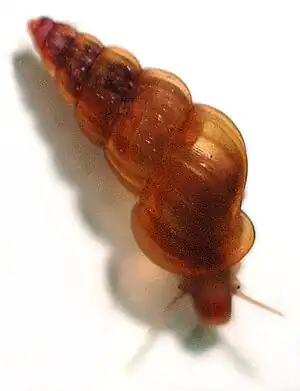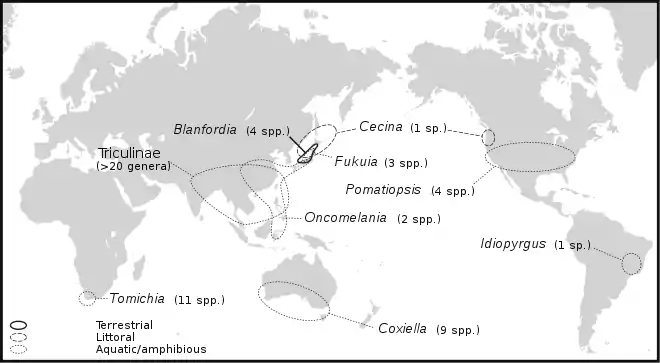| Pomatiopsidae | |
|---|---|
 | |
| A live individual of Oncomelania hupensis | |
| Scientific classification | |
| Domain: | Eukaryota |
| Kingdom: | Animalia |
| Phylum: | Mollusca |
| Class: | Gastropoda |
| Subclass: | Caenogastropoda |
| Order: | Littorinimorpha |
| Superfamily: | Truncatelloidea |
| Family: | Pomatiopsidae Stimpson, 1865 |
Pomatiopsidae is a family of small, mainly freshwater snails, (some also occur in other habitats) that have gills and an operculum, aquatic gastropod mollusks in the superfamily Truncatelloidea (according to the taxonomy of the Gastropoda by Bouchet & Rocroi, 2005).
Pomatiopsidae are well known as intermediate hosts of Asian schistosomes.[1]
Distribution
Species in the family Pomatiopsidae occur worldwide.[1] The generic diversity of Pomatiopsinae is particularly high in the Japanese Archipelago, where four of the eight genera, including two endemics, are recorded.[1] The subfamily Triculinae radiated as aquatic snails in freshwater habitats in Southeast Asia.[1]
Description
The American malacologist William Stimpson first defined this taxon as Pomatiopsinae in 1865.[4] Stimpson's diagnosis reads as follows:[4]
Pomatiopsinae, with the shell and operculum as in the Rissoinae. Foot with lateral sinuses. Size small. Amphibious. Genus Pomatiopsis, Tryon.
Subfamilies
The family Pomatiopsidae consists of 2 subfamilies (according to the taxonomy of the Gastropoda by Bouchet & Rocroi, 2005)[5] that follows classification by Davis (1979):[6]
- Subfamily Pomatiopsinae Stimpson, 1865 - synonyms: Hemibiinae Heude, 1890; Tomichiinae Wenz, 1938;[7] Coxiellidae Iredale, 1943;[8] Oncomelaniidae Salisbury & Edwards, 1961; Cecininae Starobogatov, 1983
- Subfamily Triculinae Annandale, 1924[9]
Family-group name Rehderiellinae Brandt, 1974[12] is also in Pomatiopsidae, but it is not allocated in detail.[5]
Genera
Genera within the family Pomatiopsidae include:
- Spiripockia Simone, 2012 (not allocated to a subfamily)[13]
Subfamily Pomatiopsinae
- Blanfordia Adams, 1863[1]
- Cecina A. Adams, 1861[5][14]
- Coxiella E. A. Smith, 1894:[5] belongs in the family Tomichiidae
- Floridiscrobs Pilsbry and McGinty, 1949
- Fukuia Abbott & Hunter, 1949[1]
- Hemibia Heude, 1890[5] (species type: Oncomelania hupensis Gredler, 1881
- Idiopyrgus Pilsbry, 1911[1][15] - synonym: Aquidauania Davis, 1979:[6] belongs in the family Tomichiidae
- Oncomelania Gredler, 1881[5]
- Pomatiopsis Tryon, 1862 - the type genus of the family Pomatiopsidae[5]
- Tomichia Benson, 1851:[5][16] belongs in the family Tomichiidae
Subfamily Triculinae - there are over 20 genera in Triculinae[1]
tribe Triculuni
- Delavaya Heude, 1889[5][11]
- Fenouilia Heude, 1889[11]
- Lithoglyphopsis Thiele, 1928[17][18]
- Tricula Benson, 1843 - type genus of the tribe Triculuni[5][11]
tribe Jullieniini
- Hubendickia Brandt, 1968[6]
- Hydrorissoia Bavay, 1895[6]
- Jullienia Crosse & P. Fischer, 1876 - type genus of the tribe Jullieniini[5]
- Karelainia Davis, 1979[6]
- Kunmingia Davis & Kuo in Davis, 1981[17][18]
- Neoprososthenia Davis & Kuo in Davis, Kuo, Hoagland, Chen, Yang & Chen, 1984[17][18]
- Pachydrobiella Thiele, 1928[6] - with the only species Pachydrobiella brevis (Bavay, 1895)[6]
- † Paraprososthenia Annandale, 1919[6]
- Saduniella Brandt, 1970[6] - with the only species Saduniella planispira Brandt, 1970[6]
tribe Lacunopsini
- Lacunopsis Deshayes, 1876 - type genus of the tribe Lacunopsini[5]
tribe Pachydrobiini
- Gammatricula Davis & Liu in Davis, Liu & Chen, 1990[19]
- Halewisia Davis, 1979[11] - with the only species Halewisia expansa (Brandt, 1970)[6]
- Jinghongia Davis in Davis & Kang, 1990[11]
- Neotricula Davis in Davis, Subba Rao & Hoagland, 1986[11]
- Pachydrobia Crosse & P. Fischer, 1876[11] - type genus of the tribe Pachydrobiini[5]
- Robertsiella Davis & Greer, 1980[11]
- Wuconchona Kang, 1983[11]
Rehderiellinae is not allocated to a subfamily[5]
- Rehderiella Brandt, 1974 - type genus of the taxon Rehderiellinae[5]
Ecology
The Pomatiopsidae have various life habits: aquatic, amphibious, littoral, halophilic, cavernicolous and even terrestrial.[1][13] Terrestrial taxa occur only on the Japanese Archipelago located in East Asia (Blanfordia).[1] Tomichia and Coxiella include several halophilic species occurring on saline lakes.[1]
Pomatiopsidae invaded freshwater habitats from marine ones in one or in two independent lineages.[20] They also invaded terrestrial habitats from freshwater habitats in two independent lineages.[1]
| Genus | Number of species | Habitat |
|---|---|---|
| Blanfordia | 3[1] | terrestrial[1] |
| Cecina | 8[3] | littoral of the sea[3] |
| Coxiella | 10[6] (one of them extinct)[6] | saline lakes[21] |
| Fukuia | 3[1] | terrestrial and freshwater, amphibious, often arboreal[1] |
| "Fukuia" ooyagii - unassigned to genus[1] | 1 | freshwater[1] |
| Hemibia | ?? | ?? |
| Idiopyrgus | 1-3 species[1][15] | freshwater[15] |
| Oncomelania | 2[1] | freshwater, marshy ground, seasonally amphibious[1] |
| Pomatiopsis | 4[6] | marshy ground, amphibious[1] |
| Tomichia | 11[1] | freshwater, brackish,[16] saline lakes[1] |
| Delavaya | ? | ? |
| Fenouilia | ? | freshwater |
| Lithoglyphopsis | ? | ? |
| Tricula | 15-20+ | freshwater |
| Hubendickia | 16[6] | ? |
| Hydrorissoia | 7[6] | ? |
| Jullienia | 10[6] | ? |
| Karelainia | 4[6] | ? |
| Kunmingia | ? | ? |
| Neoprososthenia | ? | ? |
| Pachydrobiella | 1[6] | ? |
| † Paraprososthenia | fossil, freshwater lake beds | |
| Saduniella | 1[6] | ? |
| Lacunopsis | 12[6] | ? |
| Gammatricula | 4 | ? |
| Halewisia | 1[6] | ? |
| Jinghongia | ? | ? |
| Neotricula | 2 (at least)[1] | freshwater |
| Pachydrobia | 10[6] | ? |
| Robertsiella | 3[22] | freshwater, streams[22] |
| Wuconchona | ? | ? |
| Rehderiella | ? | ? |
| Spiripockia | 1[13] | cavernicolous[13] |
References
This article incorporates public domain text from the reference[4] and CC-BY-2.0 from the reference[1]
- 1 2 3 4 5 6 7 8 9 10 11 12 13 14 15 16 17 18 19 20 21 22 23 24 25 26 Kameda, Y.; Kato, M. (2011). "Terrestrial invasion of pomatiopsid gastropods in the heavy-snow region of the Japanese Archipelago". BMC Evolutionary Biology. 11: 118. doi:10.1186/1471-2148-11-118. PMC 3102040. PMID 21545707.
- ↑ Brown D. S. (1994). Freshwater Snails of Africa and their Medical Importance. Taylor & Francis. ISBN 0-7484-0026-5.
- 1 2 3 Prozorova, L. A. (2003). "Morphological Features of Supralittoral Mollusks of the Genus Cecina (Gastropoda: Pomatiopsidae) from Peter the Great Bay, Sea of Japan". Russian Journal of Marine Biology. 29: 49–52. doi:10.1023/A:1022827920781.
- 1 2 3 Stimpson W. (1865). "Researches upon the Hydrobiinae and allied forms chiefly made upon materials in the museum of the Smithsonian Institution". Smithsonian Miscellaneous Collections 7(201): 1-59. page 4.
- 1 2 3 4 5 6 7 8 9 10 11 12 13 14 15 Bouchet, Philippe; Rocroi, Jean-Pierre; Frýda, Jiri; Hausdorf, Bernard; Ponder, Winston; Valdés, Ángel & Warén, Anders (2005). "Classification and nomenclator of gastropod families". Malacologia. Hackenheim, Germany: ConchBooks. 47 (1–2): 1–397. ISBN 3-925919-72-4. ISSN 0076-2997.
- 1 2 3 4 5 6 7 8 9 10 11 12 13 14 15 16 17 18 19 20 21 22 23 24 25 Davis G. M. (1979). "The origin and evolution of the gastropod family Pomatiopsidae, with emphasis on the Mekong river Triculinae". Academy of natural Sciences of Philadelphia, Monograph 20: 1-120. ISBN 978-1-4223-1926-0.
- ↑ Wenz W. A. (1938). Handbuch der Paläozoologie 6(1): 51, 63.
- ↑ Iredale T. (1943). The Australian Zoologist 10(2): 209.
- ↑ Annandale N. (1924). "Studies on Schistosomiasis japonica. Appendix A. The molluscan hosts of the human blood fluke in China and Japan, and species liable to be confused with them". American Journal of Hygiene, Monographic Series 3: 269-294, plate 26. page 276.
- ↑ Annandale N. (1924). Journal and Proceedings, Asiatic Society of Bengal new series 19(9): 403.
- 1 2 3 4 5 6 7 8 9 10 Davis G. M. & Kang Z.-B. (1990). "The genus Wuconchona of China (Gastropoda: Pomatiopsidae: Triculinae): anatomy, systematics, cladistics, and transmission of Schistosoma". Proceedings of the Academy of Natural Sciences of Philadelphia 142: 119-142. JSTOR 4064974
- ↑ Brandt R. A. (1974). "The non-marine aquatic Mollusca of Thailand". Archiv für Molluskenkunde 105(1-4): 423 pp., 30 plates. page 70.
- 1 2 3 4 Simone, L. R. L. (2012). "A new genus and species of cavernicolous Pomatiopsidae (Mollusca, Caenogastropoda) in Bahia, Brazil" (PDF). Papéis Avulsos de Zoologia. 52 (40): 515–524. doi:10.1590/s0031-10492012022000001.
- ↑ WoRMS (2010). Cecina A. Adams, 1861. Accessed through: World Register of Marine Species at http://www.marinespecies.org/aphia.php?p=taxdetails&id=397033 on 2011-04-04
- 1 2 3 Malek E. A. (1983). "The South American hydrobioid genus Idiopyrgus Pilsbry, 1911". The Nautilus 97(1): 16-20.
- 1 2 Rosenberg, G. (2010). Tomichia Benson, 1851. Accessed through: World Register of Marine Species at http://www.marinespecies.org/aphia.php?p=taxdetails&id=405098 on 2011-04-04
- 1 2 3 Guan F. & Niu A. O. (2009). 拟钉螺及其传播的血吸虫的种系发生 [Phylogenetlc study on Triculinae and the associated Schistosoma] (PDF). International Journal of Medical Parasitic Diseases (in Chinese). 36 (6): 412–416. doi:10.3760/cma.j.issn.1673-4122.2009.06.011. Archived from the original (PDF) on 2016-03-04. Retrieved 2011-07-22.
- 1 2 3 Davis G. M., Wilke T., Zhang Y., Xu X.-J., Qiu C.-P., Spolsky C., Qiu D.-C., Li Y., Xia M.-Y. & Feng Z. (1999). "Snail-Schistosoma, Paragonimus interactions in China: population ecology, genetic diversity, coevolution and emerging diseases". Malacologia 41(2): 355-377.
- ↑ Wilke T., Davis G. M., Gong X. & Liu H. X. (2000). "Erhaia (Gastropoda: Rissooidea): phylogenetic relationships and the question of Paragonimus coevolution in Asia". American Journal of Tropical Medicine and Hygiene 62(4): 453-459. PDF Archived 2006-07-15 at the Wayback Machine.
- ↑ Strong, E. E.; Gargominy, O.; Ponder, W. F.; Bouchet, P. (2007). "Global diversity of gastropods (Gastropoda; Mollusca) in freshwater". Hydrobiologia. 595: 149–166. doi:10.1007/s10750-007-9012-6. hdl:10088/7390.
- ↑ Williams, W. D.; Mellor, M. W. (1991). "Ecology of Coxiella (Mollusca, Gastropoda, Prosobranchia), a snail endemic to Australian salt lakes". Palaeogeography, Palaeoclimatology, Palaeoecology. 84 (1–4): 339–355. doi:10.1016/0031-0182(91)90053-T.
- 1 2 Attwood, S. W. (2005). "Robertsiella Silvicola, A New Species of Triculine Snail (Caenogastropoda: Pomatiopsidae) from Peninsular Malaysia, Intermediate Host of Schistosoma Malayensis (Trematoda: Digenea)". Journal of Molluscan Studies. 71 (4): 379–391. doi:10.1093/mollus/eyi040.
External links
- Stimpson W. (1865). "Researches upon the Hydrobiinae and allied forms chiefly made upon materials in the museum of the Smithsonian Institution". Smithsonian Miscellaneous Collections 7(201): 1-59. page 4
- Davis G. M., Chen C.-E., Wu C., Kuang T.-F., Xing X.-G., Li L., Liu W.-J. & Yan Y.-L. (1992). "The Pomatiopsidae of Hunan, China (Gastropoda, Rissoacea)". Malacologia 34(1-2): 143-342.
- Guan, F.; Niu, A. O.; Attwood, S. W.; Li, Y. L.; Zhang, B.; Zhu, Y. H. (2008). "Molecular phylogenetics of Triculine snails (Gastropoda: Pomatiopsidae) from southern China". Molecular Phylogenetics and Evolution. 48 (2): 702–707. doi:10.1016/j.ympev.2008.04.021. PMID 18502667.
- Liu, L.; Huo, G.-N.; He, H.-B.; Zhou, B.; Attwood, S. W. (2014). "A phylogeny for the Pomatiopsidae (Gastropoda: Rissooidea): a resource for taxonomic, parasitological and biodiversity studies". BMC Evolutionary Biology. 14 (1): 29. doi:10.1186/1471-2148-14-29. PMC 4016560. PMID 24548800.
